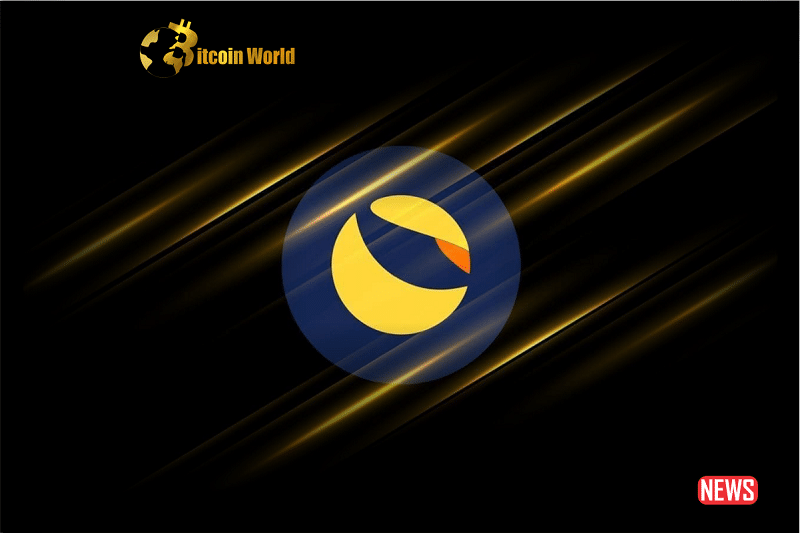Heads up, crypto enthusiasts! The Terra Luna Classic (LUNC) community is buzzing with anticipation as they count down the days to the mainnet 2.1.0 parity upgrade, slated for June 14th, 2023. Think of it as a major software update, but for a blockchain with some serious history. Despite a rollercoaster ride, LUNC has shown impressive resilience, recently climbing over 10% in the global crypto market cap charts in just 24 hours. But the question on everyone’s mind is: can this upgrade reignite the spark and bring its stablecoin sibling, Terra Stablecoin (USTC), along for the ride?
What’s the Big Deal with the Parity Upgrade?
Imagine different computer systems finally speaking the same language. That’s essentially what this parity upgrade aims to achieve. It will make the original Terra Classic network fully compatible with all blockchains built using the Cosmos software development kit (SDK), including the newer Terra 2.0. Why is this important? Let’s break it down:
- Enhanced Interoperability: LUNC will be able to seamlessly interact with a wider range of blockchain applications and services within the Cosmos ecosystem. Think of it as opening up new avenues for growth and utility.
- Developer Opportunities: This upgrade could attract more developers to build on the Terra Classic network, leading to innovative new applications and use cases.
- Relevance in the Crypto Space: By staying compatible with the latest technologies, LUNC aims to solidify its position in the ever-evolving world of decentralized finance (DeFi).
Can This Upgrade Fix USTC?
That’s the million-dollar question, isn’t it? While LUNC has seen positive price movement, USTC hasn’t followed suit. The community is actively exploring solutions to restore USTC’s peg to the US dollar. One key initiative involves creating a staking vault for USTC through a gradual repeg strategy. This involves a shared liquidity pool between LUNC and USTC. Here’s a glimpse into the efforts:
- USTC Staking Vault: The idea is to create a mechanism where users can stake USTC, potentially earning rewards and contributing to its price stability.
- LUNC/USTC Liquidity Pool: A shared pool aims to provide liquidity and facilitate trading between the two tokens, which is crucial for the repeg efforts.
- Burn Tax Increase: Major exchanges like Binance and KuCoin have supported a proposed 0.5% burn tax increase. This means a small percentage of each LUNC transaction is permanently removed from circulation, potentially increasing scarcity and value over time.
The AI Factor: What’s Edward Kim Up To?
Adding another layer of excitement, Edward Kim, a key engineer within the LUNC community, is currently testing an AI app chain specifically designed for LUNC. While details are still emerging, the potential implications are significant. Imagine AI-powered applications running on the Terra Classic blockchain, opening up possibilities for things like:
- Smart Contracts with AI: More sophisticated and automated agreements.
- Data Analysis and Insights: Leveraging AI to analyze on-chain data and provide valuable insights to the community.
- New Decentralized Applications (dApps): Entirely new types of applications powered by AI and blockchain technology.
$1 Trillion Milestone: What Does It Mean?
The article mentions Terra Luna Classic (LUNC) surpassing $1 trillion, an all-time high. It’s important to clarify that this likely refers to the cumulative volume traded, not the market capitalization. Reaching such a trading volume signifies significant interest and activity within the LUNC market. Coupled with a staking ratio of 14.6%, it suggests a strong commitment from a portion of the community who are locking up their tokens to support the network.
Looking Ahead: What are the Key Takeaways?
The future success of LUNC hinges on two crucial pillars: blockchain utility and interoperability. The parity upgrade directly addresses the interoperability aspect, paving the way for greater connectivity within the Cosmos ecosystem. The development of the AI app chain further enhances the utility proposition. However, challenges remain, particularly in the effort to repeg USTC.
Here’s a quick summary of the key aspects:
| Aspect | Details | Potential Impact |
|---|---|---|
| Parity Upgrade (Mainnet 2.1.0) | Compatibility with Cosmos-based blockchains, including Terra 2.0. | Increased interoperability, developer opportunities, stronger network. |
| USTC Repeg Efforts | Staking vault, LUNC/USTC liquidity pool, burn tax increase. | Potential for USTC price stabilization and regaining its peg. |
| LUNC AI App Chain | Development of an AI-focused blockchain for LUNC. | Innovative applications, enhanced utility, potential for new use cases. |
| Community Enthusiasm | High staking ratio, active participation in governance proposals. | Strong support for the project’s development and future. |
What’s Next for Terra Luna Classic?
As the LUNC community eagerly awaits the parity upgrade, there’s a palpable sense of hope and determination. While the journey to recovery is ongoing, these advancements represent significant steps forward. The focus on interoperability and exploring new technological frontiers like AI could be crucial in attracting broader interest and solidifying LUNC’s place in the ever-evolving crypto landscape. Keep an eye on June 14th – it could be a pivotal moment for Terra Luna Classic.
Disclaimer: The information provided is not trading advice, Bitcoinworld.co.in holds no liability for any investments made based on the information provided on this page. We strongly recommend independent research and/or consultation with a qualified professional before making any investment decisions.


